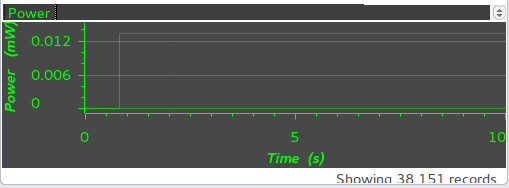Hello,
I would like to develop a wireless sensor node with the Launchpad MSP430FR5969. The node will sleep most of the time and I only need to interrupt it once an hour, while the precise timing is not important at all. I thought that using the RTC interrupt would be the way to go. According to the datasheet, I could put it into the LPM3.5 sleep mode which should consume about 0.5μA, which sounds great. However, I am not able to achieve such a low consumption.
I opened the example msp430fr59xx_lpm3-5_01.c in the CCS6.1.1.00022, ran it in the debug mode, analyzed with the Energy Trace and it measured the mean current of 3.4μA. I expected something around those 0.5μA.
(The voltage for the Energy Trace was set to 3V)
Then I tried the example msp430fr59xx_lpm4.c which runs in the LPM4 mode, but again the Energy Trace measured the very same mean current of 3.4μA. Again I expected something around 0.5μA or even lower.

Maybe I am doing something wrong, I am really new to the MSP430 world. Before I worked with the Arduino (Atmega328p).
Here is the datasheet mentioning the consumption of only 0.2 - 1.7μA:
www.ti.com/.../specifications
And here is the code of the LPM4 example (msp430fr59xx_lpm4.c):
#include <msp430.h>
int main(void)
{
WDTCTL = WDTPW | WDTHOLD; // Stop WDT
// Configure GPIO
P1OUT = 0;
P1DIR = 0xFF;
P2OUT = 0;
P2DIR = 0xFF;
P3OUT = 0;
P3DIR = 0xFF;
P4OUT = 0;
P4DIR = 0xFF;
PJOUT = 0;
PJDIR = 0xFFFF;
// Disable the GPIO power-on default high-impedance mode to activate
// previously configured port settings
PM5CTL0 &= ~LOCKLPM5;
// Clock System Setup
CSCTL0_H = CSKEY >> 8; // Unlock CS registers
CSCTL1 = DCOFSEL_6; // Set DCO to 8MHz
CSCTL2 = SELA__VLOCLK | SELS__DCOCLK | SELM__DCOCLK; // Set SMCLK = MCLK = DCO
// ACLK = VLOCLK
CSCTL3 = DIVA__1 | DIVS__1 | DIVM__1; // set all dividers
CSCTL0_H = 0; // Lock CS registers
__bis_SR_register(LPM4_bits);
__no_operation(); // For debugger
}
I would be really grateful for any hint.
Thanks a lot,
Michal


